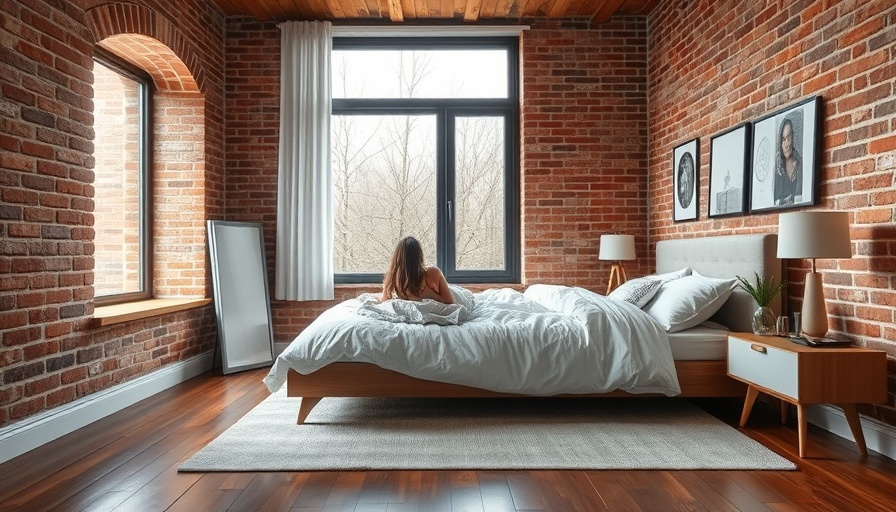
Transform Your Small Space: Design With Intention
Living in a small home can often feel constraining, but with the right design approach, it can transform into a sanctuary that is both beautiful and functional. A small home doesn't mean small dreams. In fact, as Alex Lee highlights in the video, it invites us to be more intentional about the spaces we craft. This article explores ten crucial design tips that not only help small spaces feel larger but also enhance our day-to-day lives.
In '10 Small Home Design Tips | Small Space Hacks You Need To Know | Interior Design Ideas', the discussion dives into vital design strategies for compact living spaces, and we’re breaking down its key ideas while adding our own perspective.
Embrace Vertical Solutions: Using Upwards
One major tip is to look upwards, optimizing wall space. Shelves that reach the ceiling create an illusion of height, which is essential in smaller homes where every square meter counts. Floating cabinets or hanging plants can free up floor space, yielding a light and airy aesthetic. This simple shift encourages spatial creativity, making the environment feel more expansive.
The Power of Multifunctional Furniture
In a compact space, multifunctionality becomes indispensable. Every piece of furniture should offer more than mere aesthetics. Today’s innovative designs include Murphy beds that fold seamlessly away, maximally utilizing space by converting the living area into a functional workspace. Choosing furniture that adapts as needs change adds versatility, vital for modern living.
Light It Up! How Lighting Affects Perception
Light can drastically alter the perception of space. To maximize natural light, consider sheer curtains and open windows that flood the home with sunlight. However, it's also crucial to layer artificial lighting, creating a warm and inviting atmosphere. Ambient lights for general illumination, task lighting for specific areas, and accents to highlight decor can transform tight spaces into welcoming areas.
Strategic Use of Color
Color plays a strategic role in small homes. Light tones amplify space by reflecting natural light, fostering a calm environment. For those who appreciate bolder hues, using them as accents can create focal points without overwhelming the space. For example, a navy blue wall can ground a room and provide a strong visual anchor.
Reflective Surfaces: Mirrors and More
Mirrors are a small space staple, not just for self-reflection but for creating an illusion of depth. When properly placed, they bounce light around and visually double your space. Consider incorporating mirrored furniture or reflective tiles for a rhythmic flow and brightness that enhances the overall design.
Intentional Decluttering
The concept of decluttering may invoke images of stark minimalism, but in reality, it’s about intentionality. Curate decorative items purposefully, and group them by texture or color. This targeted approach not only maintains tidiness but allows your personal style to shine through without creating chaos.
The Essence of Negative Space
Less is often more in design. Embracing empty spaces—like vacant corners or clear floors—invites calmness into a room. These intentional pauses in design give the eye a place to rest, creating balance within the space. Aim for pockets of airiness to elevate the overall design experience.
Millennial Design Trends: Blurring Boundaries
Fluidity in space can make smaller homes feel much larger. By creating open transitions between different areas—like using open shelving instead of solid walls—you can encourage a warm, inviting atmosphere. This design choice not only maximizes space but also enhances social interactions, making homes feel vibrant.
Craft a Visual Focal Point
Every room benefits from a focal point. Whether it’s a striking light fixture, a work of art, or a textured wall, having an anchor helps to structure the remaining design elements of the room. This visual anchor allows everything else to complement rather than compete for attention.
Design for Daily Rituals
True comfort in your small space emerges when design accommodates daily rituals. Consider placing a cozy reading nook or a small garden terrace to incorporate delightful everyday experiences into your space. Envision spaces that nurture your habits—these personal touches can elevate even the tiniest of homes into serene sanctuaries.
As we explore these ten small home design tips, it’s clear that being intentional creates not just a visually pleasing environment, but a deeply human one. Your small home can indeed thrive with beauty, functionality, and personality.
If you’re keen on broadening your understanding of design innovations, ARCHIDEX 2025 offers an excellent opportunity to dive deeper into this world. Check it out and get inspired! Don’t forget to subscribe for more insights into transforming your living space.
 Add Row
Add Row  Add
Add 




Write A Comment